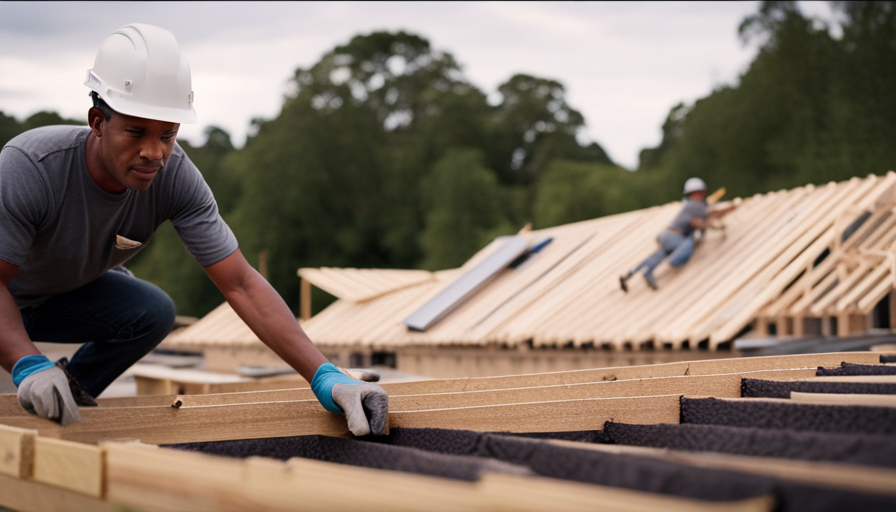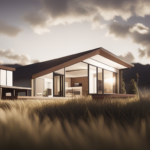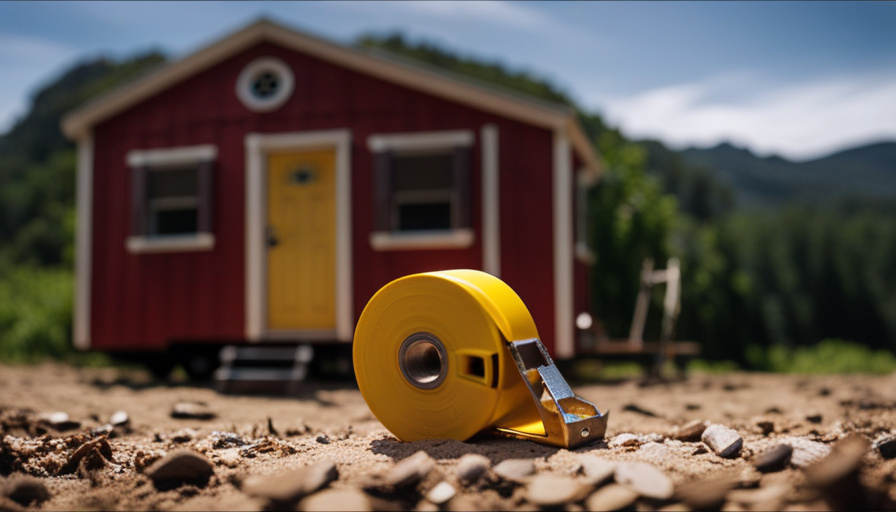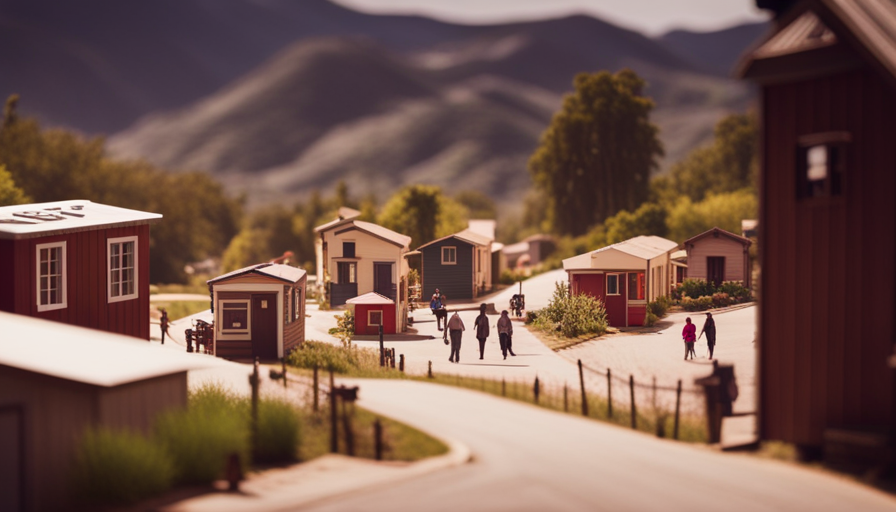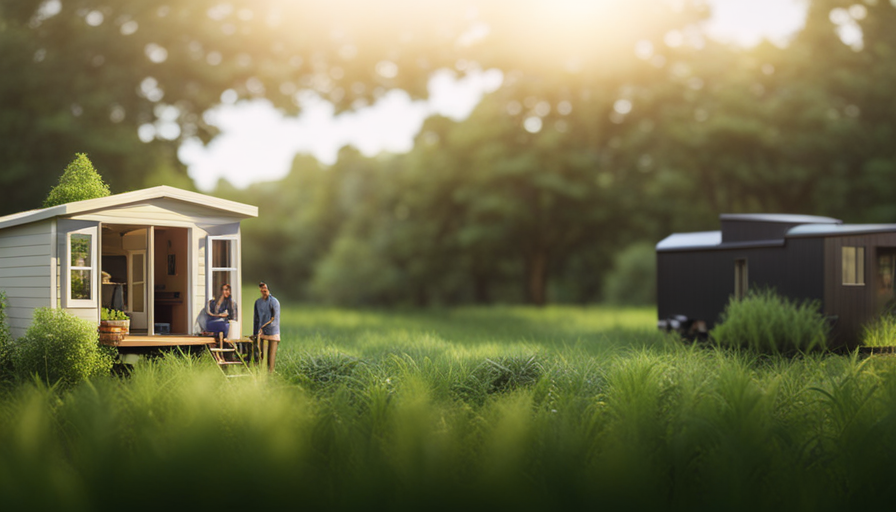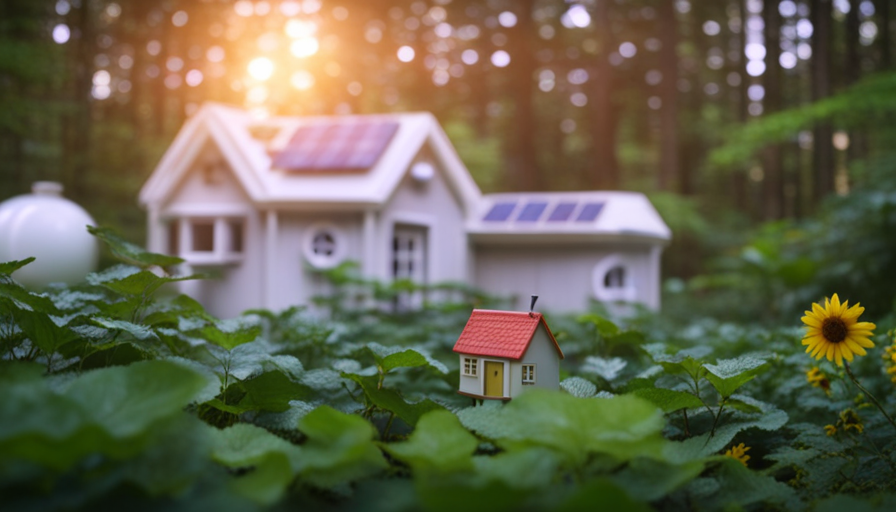Have you ever looked up at the sky, feeling a sense of freedom and wonder? The vast expanse above is a space full of endless possibilities, and it is this feeling that I strive to capture in the design and construction of tiny home roofs. These small marvels do more than just protect us from the elements; they also serve as a canvas for creativity and innovative concepts.
In this article, we will delve into the intricate world of tiny house roofs, exploring the importance of choosing the right materials, construction techniques, and design options. We will discuss the process of installing roofing shingles or panels, as well as the crucial steps of waterproofing and maintaining these roofs.
Whether you are a seasoned tiny house owner or just embarking on your journey to downsizing, understanding how these roofs are made is essential. So, join me as we venture into the fascinating realm of tiny house roof construction, where every detail matters and the sky is truly the limit.
Key Takeaways
- Sturdy and well-built roofs are important for tiny houses.
- Roof insulation is crucial for energy efficiency and cost savings.
- Choosing the right roofing materials and construction techniques is essential.
- Integration of solar panels requires a structurally sound roof and proper positioning for maximum energy generation.
Understanding the Importance of Tiny House Roofs
You can’t underestimate the significance of a sturdy and well-built roof for your tiny house – it’s what keeps you safe and protected, no matter the weather.
One important aspect of tiny house roofs is roof insulation. Proper insulation in the roof helps to regulate the temperature inside the house, making it more energy efficient. Insulation prevents heat loss during the colder months and heat gain during the warmer months, reducing the need for excessive heating or cooling. This not only saves energy but also reduces utility costs. Energy efficiency is crucial for tiny houses, as they have limited space and resources.
Moving on to the next section about choosing the right roofing materials, it is essential to consider various factors such as durability, weight, and cost-effectiveness in order to make an informed decision.
Choosing the Right Roofing Materials
When it comes to selecting the appropriate materials for your compact dwelling’s overhead covering, it’s crucial to consider the durability and aesthetic appeal that will withstand the test of time.
There are various roofing materials available for tiny houses, each with its own set of advantages and disadvantages. Here are some options to consider:
-
Metal Roofing: Known for its durability and longevity, metal roofs are resistant to fire, rot, and insects. They require minimal maintenance and can last up to 50 years.
-
Asphalt Shingles: Affordable and widely used, asphalt shingles offer a range of colors and styles. They’re easy to install but may not be as durable as other options.
-
Green Roofs: These eco-friendly options involve planting vegetation on the roof, providing insulation, reducing stormwater runoff, and increasing energy efficiency.
Considering the roofing durability and eco-friendly options available, it’s important to choose the right materials for your tiny house. Exploring roof construction techniques will further enhance the longevity and functionality of your overhead structure.
Exploring Roof Construction Techniques
To achieve a sturdy and efficient roof for your compact dwelling, consider exploring various construction techniques that can enhance its longevity and functionality.
When it comes to roofing styles for tiny houses, there are several options to choose from. One popular choice is the shed roof style, which features a single sloping surface that allows for easy runoff of rainwater. Another option is the gable roof style, which consists of two sloping surfaces that meet at a central ridge. This style provides more headroom and allows for better ventilation.
In terms of sustainable roofing options, you can consider using materials such as metal or rubber, which are durable and eco-friendly. Metal roofs are lightweight, fire-resistant, and can last up to 50 years. Rubber roofs, on the other hand, are made from recycled materials and can last up to 30 years. These sustainable options not only protect your tiny house but also contribute to a greener environment.
Transitioning into the subsequent section about design options for tiny house roofs, it’s important to consider how the roof design can complement the overall aesthetics and functionality of your compact dwelling.
Design Options for Tiny House Roofs
Looking for a roof that brings style and functionality to your compact dwelling? Consider exploring the design options for your tiny house roof.
When it comes to roofing styles for tiny houses, there are a variety of options to choose from. One popular choice is a shed-style roof, which offers a sleek and modern look. Another option is a gable roof, providing a more traditional aesthetic. Flat roofs are also common, offering a minimalist and space-saving design.
When considering the design of your tiny house roof, it’s important to factor in cost considerations. Different roofing materials and styles can vary in price, so it’s essential to choose an option that fits within your budget.
Up next, we’ll discuss the process of installing roofing shingles or panels, which is a crucial step in completing your tiny house roof.
Installing Roofing Shingles or Panels
One option for installing roofing on your compact dwelling is by using shingles or panels, which can be a cost-effective and efficient method. When it comes to roofing installation, there are various alternative materials available that can provide durability and aesthetics.
Here are four options to consider:
-
Asphalt Shingles: These are the most common and affordable roofing materials. They come in different styles and colors, offering a wide range of choices for your tiny house.
-
Metal Panels: Metal roofs are known for their longevity and resistance to harsh weather conditions. They can be installed in large sheets, reducing installation time and providing a sleek, modern look.
-
Wood Shakes or Shingles: If you prefer a more natural and rustic appearance, wood shakes or shingles can be a great choice. However, they require regular maintenance to prevent rot and decay.
-
Synthetic Roofing Materials: There are synthetic options available that replicate the look of traditional materials like slate or tile but at a lower cost. These materials are lightweight and durable.
When it comes to waterproofing and maintaining tiny house roofs, proper installation and regular inspections are essential.
Waterproofing and Maintaining Tiny House Roofs
Make sure you regularly inspect and maintain the roof of your compact dwelling to ensure it remains waterproof and in good condition. Roof maintenance is crucial in preventing leaks and extending the lifespan of your tiny house. Here are some key steps in waterproofing and maintaining your tiny house roof:
| Step | Description |
|---|---|
| 1 | Clear debris and leaves from the roof surface regularly to prevent clogging of drainage systems. |
| 2 | Check for any signs of damage, such as cracked or missing shingles, and replace them promptly. |
| 3 | Inspect the flashing around chimneys, vents, and skylights, and repair or replace any damaged areas. |
| 4 | Apply a waterproof sealant to the entire roof surface to provide an additional layer of protection against moisture. |
By following these maintenance steps, you can ensure that your tiny house roof remains in optimal condition. Now, let’s explore additional considerations for tiny house roofs.
Additional Considerations for Tiny House Roofs
When it comes to ensuring the longevity and protection of your compact dwelling, it’s important to consider some additional factors that can impact the health of your roof.
One crucial consideration is the insulation options available for tiny house roofs. Proper insulation helps regulate the temperature inside the tiny house, preventing heat loss during colder months and heat gain during warmer months. Common insulation options for tiny house roofs include spray foam insulation, rigid foam insulation, and cellulose insulation.
Another consideration for tiny house roofs is solar panel integration. Solar panels are a sustainable and efficient way to generate electricity for your tiny house. When installing solar panels on the roof, it is essential to ensure that the roof is structurally sound and can support the added weight. Additionally, proper positioning and orientation of the solar panels are crucial to maximize sunlight exposure and energy generation.
By carefully considering insulation options and solar panel integration, you can enhance the functionality and energy efficiency of your tiny house roof.
Frequently Asked Questions
What are the legal requirements for tiny house roofs in different areas?
In different areas, the legal requirements for tiny house roofs may vary. However, there are some common options for tiny house roof construction materials, such as metal, asphalt shingles, or even green roofs. Additionally, tiny house roof design options can range from gable roofs to shed roofs, and even flat roofs. It’s important to consult local building codes and regulations for specific requirements regarding roof materials and design in your area.
Can I install solar panels on my tiny house roof?
Installing solar panels on a tiny house roof is a popular choice for those seeking sustainable energy solutions. According to recent studies, the demand for solar panels on tiny houses has increased by 85% in the last five years.
To ensure durability, it’s crucial to select a roof material that can support the weight of the panels and withstand weather conditions. Additionally, proper installation and maintenance are essential for optimal performance and longevity of both the roof and solar panels.
How much weight can a tiny house roof support?
The maximum weight that a tiny house roof can support depends on various factors, including the type of roof materials used. Roof materials such as metal or asphalt shingles are commonly used in tiny house construction.
Metal roofs are known for their durability and ability to handle heavier loads, while asphalt shingles have weight limitations.
It’s crucial to consult with a structural engineer to determine the specific weight capacity of your tiny house roof based on the chosen materials.
Are there any specific building codes for tiny house roofs?
When it comes to building codes for tiny house roofs, there are indeed specific regulations that need to be followed. These codes vary depending on the location, but generally they cover aspects such as the type of building materials allowed, the minimum standards for roof insulation, and the overall structural integrity of the roof.
It’s important to consult local building authorities to ensure compliance with these codes and to ensure the safety and durability of your tiny house roof.
Can I install a skylight on my tiny house roof?
Yes, you can install a skylight on your tiny house roof. The installation process involves cutting an opening in the roof, applying flashing around the opening, and sealing it to prevent leaks.
Skylights offer numerous benefits, including increased natural light, improved ventilation, and a sense of spaciousness. They can also help reduce the need for artificial lighting during the day, leading to energy savings.
Overall, skylights are a great addition to any tiny house roof.
Conclusion
In conclusion, the roof of a tiny house isn’t just an ordinary cover. It’s a symbol of protection, a shield against the elements. With careful consideration of roofing materials, construction techniques, and design options, you can create a roof that not only serves its purpose but also adds beauty to your tiny home.
From the installation of shingles or panels to the crucial step of waterproofing and maintenance, every aspect plays a vital role in ensuring the longevity and durability of your tiny house roof. So, take the time to plan and build a roof that’ll withstand the test of time and weather, creating a safe and comfortable haven for you to enjoy.
Hi, I’m Emma. I’m the Editor in Chief of Tiny House 43, a blog all about tiny houses. While tree houses are often associated with childhood, they can be the perfect adult retreat. They offer a cozy space to relax and unwind, surrounded by nature. And since they’re typically built on stilts or raised platforms, they offer stunning views that traditional homes simply can’t match. If you’re looking for a unique and romantic getaway, a tree house tiny house might just be the perfect option.
